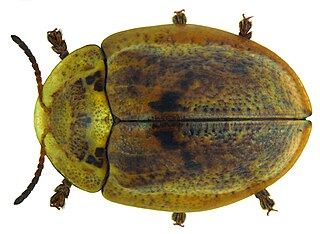
Gari is a genus of bivalve molluscs in the family Psammobiidae, known as sunset shells.
Neduba extincta, the Antioch Dunes shieldback katydid, is an extinct species of katydid that was endemic to California, United States. It was not discovered until after its extinction.

Neduba is a genus of insects in the family Tettigoniidae (katydids), which is native to North America.

Crepidula convexa is a species of sea snail, a marine gastropod mollusk in the family Calyptraeidae, the slipper snails or slipper limpets, cup-and-saucer snails, and Chinese hat snails. The maximum recorded shell length is 20 mm.

Thracia convexa is a bivalve mollusc in the family Thraciidae.
Neduba carinata is a shield-backed katydid known only from Fremont Peak in San Benito County, California. This name has often been used to describe katydids across a broad portion of the western United States, but most of its subspecies have been elevated to species level, and as currently conceived it only applies to a population on Fremont Peak with a pronotum slightly longer and narrower than the similar N. diabloica.

Neduba diabolica is a species of shield-backed katydids in the family Tettigoniidae. It is found in North America.
Metrioidea convexa is a species of leaf beetle in the family Chrysomelidae. It is found in North America.
Crenitis is a genus of water scavenger beetles in the family Hydrophilidae. There are about 19 described species in Crenitis.
Amara convexa is a species of seed-eating ground beetle in the family Carabidae. It is found in North America.

Neduba sierranus, the sierra shieldback, is a species of shield-backed katydid in the family Tettigoniidae. It is found in North America.
Desmopachria convexa is a species of predaceous diving beetle in the family Dytiscidae. It is found in North America and South America.

Neduba macneilli, or Macneill's shieldback, is a species of shield-backed katydid in the family Tettigoniidae. It is found in North America.

Physonota is a genus of tortoise beetles and hispines in the family Chrysomelidae. There are more than 40 described species in Physonota.
Linsleya is a genus of blister beetles in the family Meloidae. There are about five described species in Linsleya.
Aegialia convexa is a species of aphodiine dung beetle in the family Scarabaeidae. It is found in North America.
Brachypnoea convexa is a species of leaf beetle. It is found in North America.
Neduba steindachneri, or Steindachner's shieldback, is a species of shield-backed katydid in the family Tettigoniidae. It is found in North America.
Neduba propsti, known generally as the Catalina shield-back cricket or Propst's shieldback, is a species of shield-backed katydid in the family Tettigoniidae. It is found in North America.
Protea convexa, also known as large-leaf sugarbush, is a rare flowering shrub in the genus Protea of the family Proteaceae, which is endemic to the southwestern Cape Region of South Africa.







